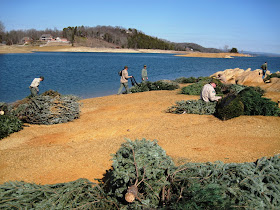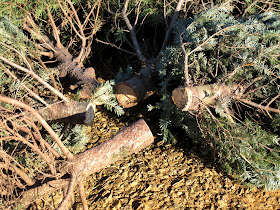Every winter Tennessee Wildlife Resources Agency replenishes and restores fish habitat on the lakes of East Tennessee. I should say creates fish habitat because there isn't much habitat on these flood control lakes. The water is drawn down in winter to allow space for additional water inflow due to flood emergencies. This draw-down creates a situation where falling trees and tree limbs can not fall into the water. Also water grasses such as mill foil can not survive because they would be located out of water high on a bank, dead, at the the shore line after draw-down.
 |
| Note the black plastic rope bundled on the trailer ramp |
 |
| Trailer used to haul trees to the habitat site |
There's about 200 trees in that pile upper left of the photo. The little quad is heading for a narrow strip of shale dividing two bodies of water. It is a natural bridge to the island we were working on. It's also an interesting ride across it.
Richard drove across that narrow, soggy strip of shale over and over at personal risk to life and limb to deliver his precious cargo. We pull the stops out for our fish down here.
A small group of workers unloads the trees and distributes them to positions on the shore line in preparation for the next operation.
The trees are placed 5 to a group, or "pod", with their trunk ends facing each other.
After all the pods are set in place a two foot long pin with a cable loop at the top is driven into the soil at the juncture point where all the trunk ends come together. Plastic rope is used to secure each tree to that peg to prevent the trees from washing away due to current and wave action.
 |
| Note the plastic line attaching the trees to the metal peg |
There now--you thought all I did was drive a 22 foot boat around in circles on the lake.
 |
| The habitat effort is huge and requires the efforts of many professionals to do it right. |
The addition of those trees among the existing rocks and boulders has created a tremendous habitat for fish on that little island. A job worth doing. Reservoir Fisheries is our job. It's our responsibility and it's not taken lightly.
 |
| This is called searching for arrow heads. |
Above we can see two thoroughly worn out professional technicians catching their breath between loads of trees. Actually they are two state workers doing what you usually see state workers doing. Just kidding.
Today has been a delightful break from driving the boat all day. I am not assigned to habitat restoration but it's great to be able to help out in the effort. I hope you found this post interesting. I will try to post more work activities in the future. I need to show you what I do on a daily basis with the boat. I'll work on that for you next time I'm on the lake. I think you'll find it interesting. I've got one more day of habitat duty and then back to cruising around in circles on the lake. Keep a look out for the Scona Lodge piece. I'm diligently working on it. It's not an easy thing to write. I might be making it harder than it really is. See ya...










Very Interesting! I've seen them dropping the trees from pontoons but not placing in coves ever! Our lake levels don't drop enough I guess to ever be able to do it from land. You have a fascinating job! This mild winter just keeps going an going, it will be spring before we know it!
ReplyDeleteNicely done Gary! Great story and tribute to the reservoir crew. Thanks!!!
ReplyDeleteJohn